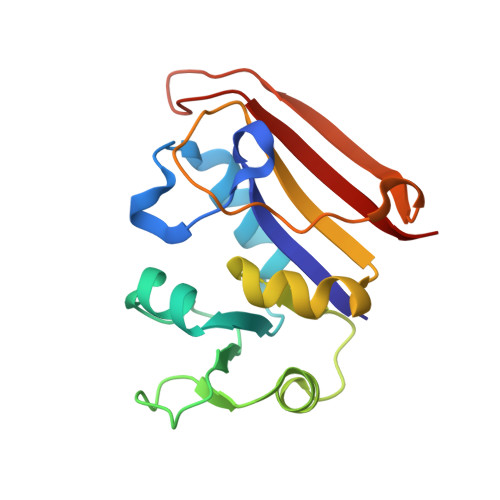Cofactor-Mediated Conformational Dynamics Promote Product Release From Escherichia coli Dihydrofolate Reductase via an Allosteric Pathway.
Oyen, D., Fenwick, R.B., Stanfield, R.L., Dyson, H.J., Wright, P.E.(2015) J Am Chem Soc 137: 9459-9468
- PubMed: 26147643
- DOI: https://doi.org/10.1021/jacs.5b05707
- Primary Citation of Related Structures:
5CC9, 5CCC - PubMed Abstract:
The enzyme dihydrofolate reductase (DHFR, E) from Escherichia coli is a paradigm for the role of protein dynamics in enzyme catalysis. Previous studies have shown that the enzyme progresses through the kinetic cycle by modulating the dynamic conformational landscape in the presence of substrate dihydrofolate (DHF), product tetrahydrofolate (THF), and cofactor (NADPH or NADP(+)). This study focuses on the quantitative description of the relationship between protein fluctuations and product release, the rate-limiting step of DHFR catalysis. NMR relaxation dispersion measurements of millisecond time scale motions for the E:THF:NADP(+) and E:THF:NADPH complexes of wild-type and the Leu28Phe (L28F) point mutant reveal conformational exchange between an occluded ground state and a low population of a closed state. The backbone structures of the occluded ground states of the wild-type and mutant proteins are very similar, but the rates of exchange with the closed excited states are very different. Integrated analysis of relaxation dispersion data and THF dissociation rates measured by stopped-flow spectroscopy shows that product release can occur by two pathways. The intrinsic pathway consists of spontaneous product dissociation and occurs for all THF-bound complexes of DHFR. The allosteric pathway features cofactor-assisted product release from the closed excited state and is utilized only in the E:THF:NADPH complexes. The L28F mutation alters the partitioning between the pathways and results in increased flux through the intrinsic pathway relative to the wild-type enzyme. This repartitioning could represent a general mechanism to explain changes in product release rates in other E. coli DHFR mutants.
Organizational Affiliation:
Department of Integrative Structural and Computational Biology and Skaggs Institute for Chemical Biology, The Scripps Research Institute, 10550 North Torrey Pines Road, La Jolla, California 92037, United States.
















